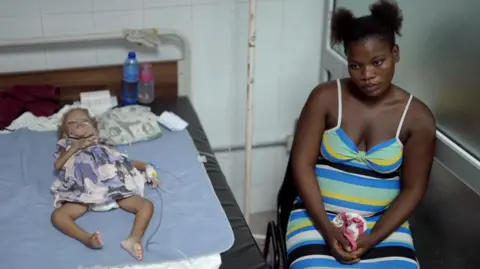 Jack Garland, BBC
Jack Garland, BBCTwo-year-old Shaina is hooked up to an IV in one of the few functioning hospitals in Haiti’s capital Port-au-Prince. Her mother Venda desperately hopes that this will alleviate the emaciated young girl’s acute malnutrition.
Shaina is one of 760,000 children on the brink of famine in Haiti.
Fearful of the gang war raging in her neighborhood, Venda was too scared to leave her home for weeks to seek treatment for her daughter.
Now that she’s made it to the pediatric ward, she hopes it’s not too late for Shaina.
“I want to get appropriate care for my child, I don’t want to lose him,” she says through tears.
Haiti has been hit by a wave of gang violence since the assassination of then-President Jovenel Moïse in 2021, and an estimated 85% of the capital is now under gang control.
Even in the hospital, Haitians are not safe from the fighting, which the United Nations says has killed 5,000 people this year alone and left the country on the brink of collapse.
The hospital’s medical director explains that the day before there were clashes between police and gang members in the emergency room among frightened patients.
The victims of violence are everywhere. A ward is full of young men with gunshot wounds.
Pierre is one of them.
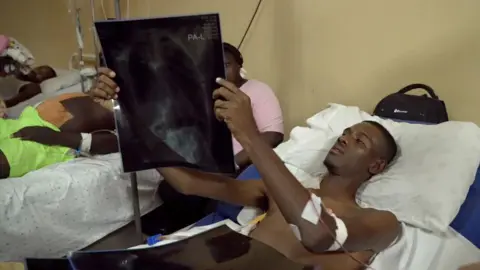 Jack Garland, BBC
Jack Garland, BBCHe says he was caught in the crossfire of a street fight on his way home from work and a bullet pierced his collarbone.
“I think if the government was more stable and had better youth programs in place, it wouldn’t get involved in the gangs,” he says of the young men who make up a large proportion of the groups terrorizing the capital.
To address the growing violence, the UN Security Council approved the establishment of a Multinational Security Assistance Mission (MSS) in October 2023.
The Kenyan-led force, financed primarily by the United States, was deployed to Haiti six months ago and tasked with restoring law and order.
The severity of gang violence becomes clear during a patrol in downtown Port-au-Prince.
Kenyan officers drive heavily armored personnel carriers (APCs) through the once bustling, now deserted areas of the capital. Shops and houses are boarded up.
Burnt-out cars and debris are piled up in the side streets – barricades that the gangs have erected to block access.
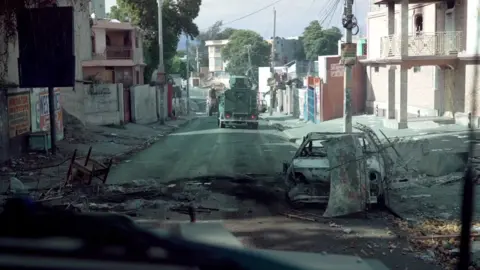 Jack Garland, BBC
Jack Garland, BBCThe convoy is weaving through the rubble when it suddenly comes under fire.
Bullets pierce the APC’s armor as the Kenyan police fire back with their assault rifles through embrasures in the vehicle’s walls.
After almost an hour of gunfire back and forth, the convoy moves on.
But it doesn’t take long before there are signs of even more horrific gang violence. A human body burns in the middle of the street.
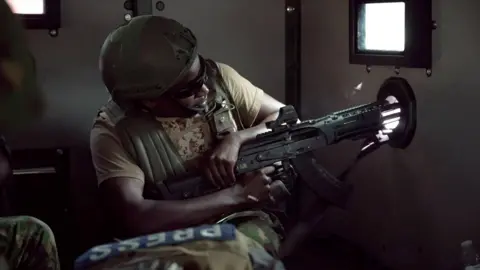 Jack Garland, BBC
Jack Garland, BBCOne of the Kenyan police officers in our APC says he suspects it was a gang member who was cornered and killed by a rival group and whose body was set on fire to send a grim warning.
The Kenyan officers on our patrol are now used to seeing such brutality on the streets of Port-au-Prince, but they also tell us they are exhausted.
In June, 400 officers arrived – but they are clearly outnumbered. In July, the Haitian government estimated that there were 12,000 armed gang members in the country.
The Kenyans were promised additional staff. When the UN approved the mission, a force of 2,500 was envisaged, but that support, due to arrive in November, has not yet materialized.
Despite the situation, the troop leadership remains optimistic. Commander Godfrey Otunge is under pressure from the Kenyan government to make this mission a success.
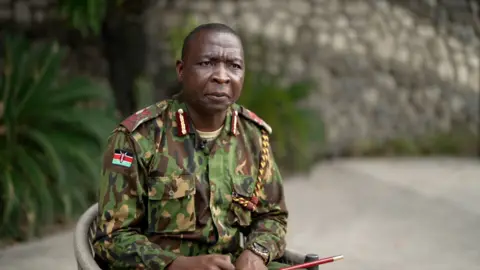 Jack Garland, BBC
Jack Garland, BBCThe mission commander says there is “overwhelming support” for the MSS in Haiti.
“The population is demanding that our team be expanded and go to other places and calm down,” he says.
The uphill battle they face is evident in a former Haitian police station that was occupied by a gang but has now been retaken by Kenyan forces.
It is still completely surrounded by gangs and as the officers climb to the roof they come under sniper fire.
Kenyan officials fire back and tell everyone to keep a low profile.
 Jack Garland, BBC
Jack Garland, BBCKenyan officers say some of their much-delayed additional forces will arrive by the end of this year, bringing their total to 1,000.
And the support is urgently needed. There are areas of Port-au-Prince that are so tightly controlled by gangs that they are virtually impenetrable to police.
In one such area, Wharf Jérémie, nearly 200 civilians were killed by a single gang over a weekend in early December.
In total, it is estimated that up to 100 gangs operate in the Port-au-Prince area, including boys as young as nine.
And the problem only seems to be getting worse. According to the UN children’s fund Unicef, the number of children recruited by the gangs has increased by 70% in a year.
One of the gang leaders they flock to is Ti Lapli, whose real name is Renel Destina.
As the leader of the Gran Ravine gang, he commands more than 1,000 men from his fortified headquarters high above Port-au-Prince.
Gangs like his have exacerbated the already dire situation in Haiti and are known to slaughter, rape and terrorize civilians.
Gran Ravine is notorious for carrying out kidnappings for ransom, a practice that has earned Ti Lapli a place on the FBI’s wanted list.
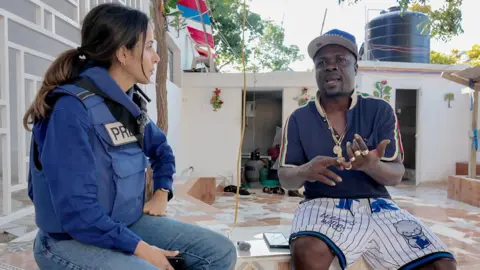 Jack Garland, BBC
Jack Garland, BBCTi Lapli tells us that he and his gang members “love our country very much” – but when he was pressed about gang rapes and murders of civilians, he claimed his men were “doing things they shouldn’t do ( towards members). rival gangs) because the same thing is being done to us.
The reason why children join Gran Ravine is simple: “The government does not create jobs, it is a country without any economic activity. We live on garbage, it’s basically a failed state.”
He failed to acknowledge the crushing influence that gangs like his have on the Haitian economy. Civilians, who are often afraid to leave their homes to work, are regularly extorted for money.
With 700,000 residents forced from their homes due to violence from groups like Gran Ravine, the capital’s schools have become camps for internally displaced people.
Negociant is one of those who had to seek shelter.
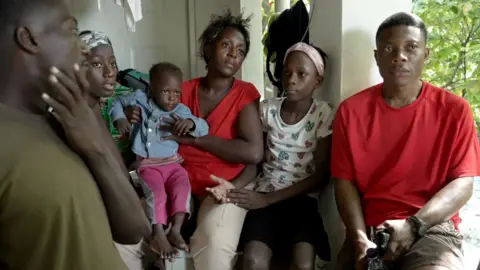 Jack Garland, BBC
Jack Garland, BBCShe sits with her five children squashed together on the small section of a school balcony they now call home.
“Just a few weeks ago I was living in my own house,” she says. “But gangs have taken over my neighborhood.”
She explains that she headed to a neighborhood called Solino until it too was overrun by gangs and she fled along with hundreds of other people.
“Today I’m on the run again to save my life and that of my children,” she says.






